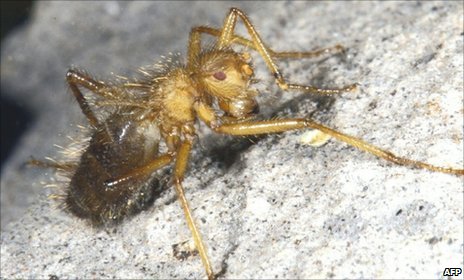If you ask any Dipterist which fly species they daydream about collecting, most will likely respond with a dazed smile and choose Mormotomyia hirsuta (family Mormotomyiidae). This little beast has only been collected twice (once in 1934 and once in 1948) and is believed to live within a single 1 metre wide crevasse on a hilltop in Kenya. This enigmatic fly has been searched for on several occasions since, but each excursion has been unsuccessful.
Meet Mormotomyia hirsuta Austen, 1936:
Dr. Robert Copeland (ICPE, Nairobi, Kenya) and Dr. Ashley Kirk-Spriggs (National Museum, Bloemfontein, South Africa) recently found and photographed multiple specimens on an expedition to the type locality (Ukazzi Hill, Kenya) at the end of November. These specimens, some of which were preserved in alcohol for future molecular analyses, will prove extremely useful for exploring the evolutionary history of flies.
Considering these flies have only ever been seen in the wild twice before, there is a considerable amount known about their larval stages and general biology. Van Emden (1950) reported that the larvae were observed feeding on bat guano, and when they are ready to pupate, affix special anal hooks to the rockface in an upright position. When Dr. V.G.L. van Someren made his observations and collections in 1948, he attempted to collect the bats that were inhabiting the narrow chasm in which these flies lived, by shooting wildly. He apparently only succeeded in dislodging more flies, which fell from the walls of the chasm and floated down in spiral patterns thanks to their long legs covered in long bristles! The adults feed on liquid substrates found on the walls of the cave (possibly liquid excretion or bat sweat) rather than feeding off of the bats themselves, as evidenced by their flexible, sponging mouthparts (as opposed to the mouthparts of parasitic bat flies [family Streblidae]).
As for where the Mormotomyiidae fit within the Diptera, Austen (1936) originally postulated they may be closely related to the Sphaeroceridae, while van Emden (1950) placed them between the Calyptratae (Muscidae, Tachinidae, etc) and the Acalyptratae (Tephritidae, Sphaeroceridae, Micropezidae, etc), possibly sister to the Scathophagidae. The odd morphology of this species (including front wings reduced to hairy, hardened spikes and knob-like halteres) certainly confound hypotheses on relationships, making the specimens preserved in alcohol all the more valuable! I expect that some papers which are examining the relationships between the families of flies may be put on hold until this species can be incorporated.
My advisor, Dr. Stephen Marshall, had originally planned on accompanying Dr.’s Copeland and Kirk-Spriggs on this expedition and helped develop the collecting strategy for this discovery, but he was forced to cancel due to scheduling conflicts. I’d like to congratulate Robert and Ashley for their good luck in re-discovering this Dipteran gem, and I look forward to learning more about Mormotomyia hirsuta in the coming months!
You can read more about this fly, including additional photos, at Dr. Kirk-Spriggs’ museum’s webpage.
References:
Austen, E. E. (1936). “A Remarkable Semi-Apterous Fly (Diptera) found in a Cave in East Africa, and representing a new Family, Genus, and Species. By Major E. E. AUSTEN, D.S.O., F.Z.S.” Proceedings of the Zoological Society of London 106(2): 425-431.
Van Emden, F. I. (1950). “MORMOTOMYIA HIRSUTA AUSTEN (DIPTERA) AND ITS SYSTEMATIC POSITION.” Proceedings of the Royal Entomological Society of London. Series B, Taxonomy 19(7-8): 121-128.


Haha nice, wingless flies are always fun…:D
Miles I think you meant “Flies are always fun…. :D”, not just wingless flies!
Only the parasitic ones…:p
That is a great discovery, thanks for sharing this news with us! Flies FTW!
Flies FTW indeed! Thanks for stopping by Ani!
As a dipterist, I dream the most about collecting Eutonnoiriella edwardsi (Tonnoir, 1939) (Psychodidae) and Usambaromyia nigrala Andersen & Sæther, 1994 (Chironomidae). And, obviously, species that belong to new species and genera. However, Mormotomyia is a very interesting genus that would be of much use in collections all over; I would thus not be disappointed to find it during my searches for nematocerous and psychodine aenigmas.
Perhaps I should have phrased it as “any Brachypteran Dipterist”… Being largely ignorant of those pesky Nematocerans, mind if I inquire why the 2 you chose are significant?
Both have been collected only once, are known from very few specimens and have yet to be placed in a phylogenetic context. Usambaromyia is the only known member of its subfamily, and might be of high value in phylogenetic reconstructions if ever rediscovered. Eutonnoiria is immediately spectacular with its 113 antennal segments – the highest number of all Diptera? – and could be interesting to look at in terms of developmental biology.
I want to add Valeseguyidae to my wishlist. This family was defined in 2006 and is known from two extinct species in amber and a single recent female.
Those each sound equally interesting, and their names are quite the mouthful! 113 antennal segments? I couldn’t imagine having to try and count those out. It must be quite the fly to behold.